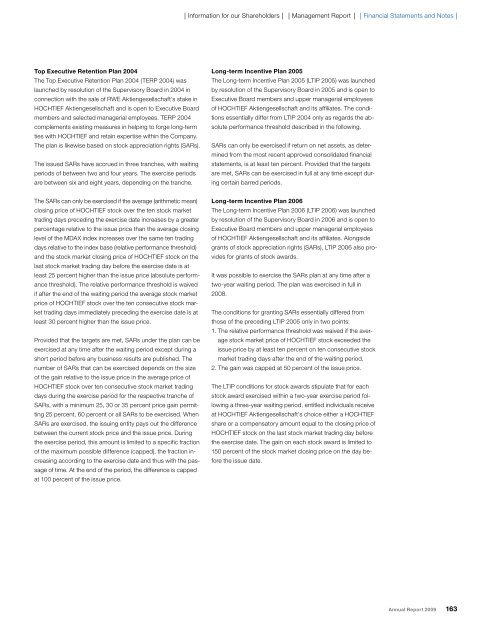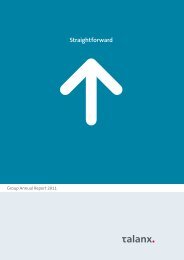ONE ROOF
ONE ROOF
ONE ROOF
You also want an ePaper? Increase the reach of your titles
YUMPU automatically turns print PDFs into web optimized ePapers that Google loves.
Top Executive Retention Plan 2004<br />
The Top Executive Retention Plan 2004 (TERP 2004) was<br />
launched by resolution of the Supervisory Board in 2004 in<br />
connection with the sale of RWE Aktiengesellschaft’s stake in<br />
HOCHTIEF Aktiengesellschaft and is open to Executive Board<br />
members and selected managerial employees. TERP 2004<br />
complements existing measures in helping to forge long-term<br />
ties with HOCHTIEF and retain expertise within the Company.<br />
The plan is likewise based on stock appreciation rights (SARs).<br />
The issued SARs have accrued in three tranches, with waiting<br />
periods of between two and four years. The exercise periods<br />
are between six and eight years, depending on the tranche.<br />
The SARs can only be exercised if the average (arithmetic mean)<br />
closing price of HOCHTIEF stock over the ten stock market<br />
trading days preceding the exercise date increases by a greater<br />
percentage relative to the issue price than the average closing<br />
level of the MDAX index increases over the same ten trading<br />
days relative to the index base (relative performance threshold)<br />
and the stock market closing price of HOCHTIEF stock on the<br />
last stock market trading day before the exercise date is at<br />
least 25 percent higher than the issue price (absolute performance<br />
threshold). The relative performance threshold is waived<br />
if after the end of the waiting period the average stock market<br />
price of HOCHTIEF stock over the ten consecutive stock market<br />
trading days immediately preceding the exercise date is at<br />
least 30 percent higher than the issue price.<br />
Provided that the targets are met, SARs under the plan can be<br />
exercised at any time after the waiting period except during a<br />
short period before any business results are published. The<br />
number of SARs that can be exercised depends on the size<br />
of the gain relative to the issue price in the average price of<br />
HOCHTIEF stock over ten consecutive stock market trading<br />
days during the exercise period for the respective tranche of<br />
SARs, with a minimum 25, 30 or 35 percent price gain permitting<br />
25 percent, 60 percent or all SARs to be exercised. When<br />
SARs are exercised, the issuing entity pays out the difference<br />
between the current stock price and the issue price. During<br />
the exercise period, this amount is limited to a specific fraction<br />
of the maximum possible difference (capped), the fraction increasing<br />
according to the exercise date and thus with the passage<br />
of time. At the end of the period, the difference is capped<br />
at 100 percent of the issue price.<br />
❘ Information for our Shareholders ❘ ❘ Management Report ❘ ❘ Financial Statements and Notes ❘<br />
Long-term Incentive Plan 2005<br />
The Long-term Incentive Plan 2005 (LTIP 2005) was launched<br />
by resolution of the Supervisory Board in 2005 and is open to<br />
Executive Board members and upper managerial employees<br />
of HOCHTIEF Aktiengesellschaft and its affiliates. The conditions<br />
essentially differ from LTIP 2004 only as regards the absolute<br />
performance threshold described in the following.<br />
SARs can only be exercised if return on net assets, as deter-<br />
mined from the most recent approved consolidated financial<br />
statements, is at least ten percent. Provided that the targets<br />
are met, SARs can be exercised in full at any time except during<br />
certain barred periods.<br />
Long-term Incentive Plan 2006<br />
The Long-term Incentive Plan 2006 (LTIP 2006) was launched<br />
by resolution of the Supervisory Board in 2006 and is open to<br />
Executive Board members and upper managerial employees<br />
of HOCHTIEF Aktiengesellschaft and its affiliates. Alongside<br />
grants of stock appreciation rights (SARs), LTIP 2006 also provides<br />
for grants of stock awards.<br />
It was possible to exercise the SARs plan at any time after a<br />
two-year waiting period. The plan was exercised in full in<br />
2008.<br />
The conditions for granting SARs essentially differed from<br />
those of the preceding LTIP 2005 only in two points:<br />
1. The relative performance threshold was waived if the average<br />
stock market price of HOCHTIEF stock exceeded the<br />
issue price by at least ten percent on ten consecutive stock<br />
market trading days after the end of the waiting period.<br />
2. The gain was capped at 50 percent of the issue price.<br />
The LTIP conditions for stock awards stipulate that for each<br />
stock award exercised within a two-year exercise period following<br />
a three-year waiting period, entitled individuals receive<br />
at HOCHTIEF Aktiengesellschaft’s choice either a HOCHTIEF<br />
share or a compensatory amount equal to the closing price of<br />
HOCHTIEF stock on the last stock market trading day before<br />
the exercise date. The gain on each stock award is limited to<br />
150 percent of the stock market closing price on the day before<br />
the issue date.<br />
Annual Report 2009 163
















